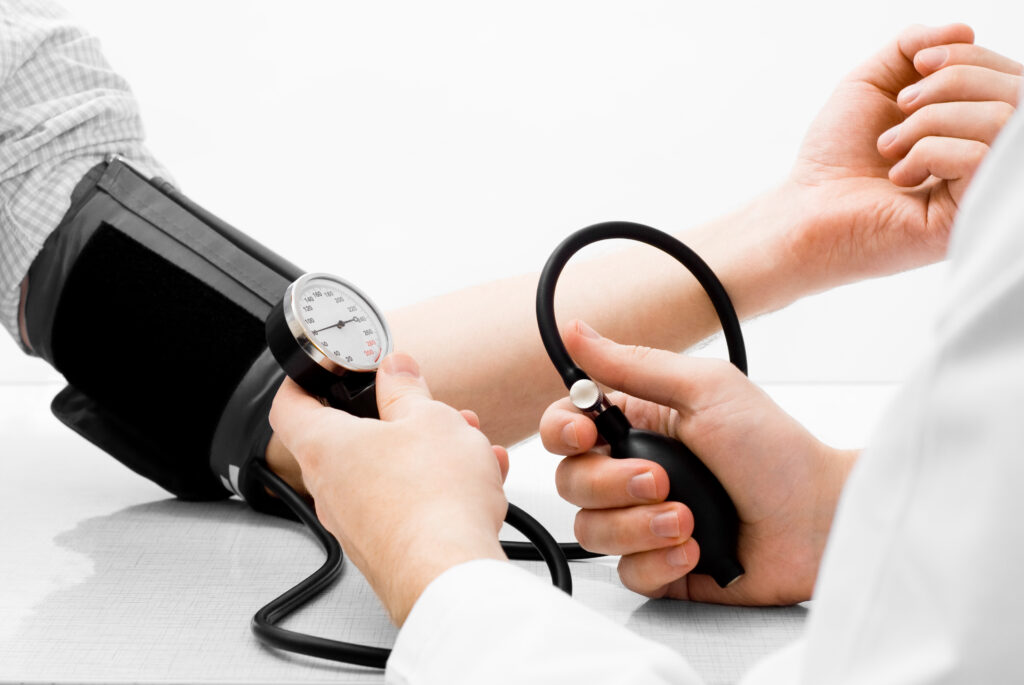Blood pressure is a combination of two major factors: the amount of blood the heart pumps and how difficult it is for that blood to move through the arteries. These two are inversely related. High blood pressure results if the heart must pump higher volumes or if the arteries are narrow. This is a common condition, and the dangers are acute.

The Dangers of High Blood Pressure
Conditions that increase blood pressure cause the heart to work harder to pump blood, and unfortunately even small changes in the blood pressure metrics (i.e. 115 to 135) can double the risk of a cardiovascular event.
Symptoms may include shortness of breath, headaches, or even nosebleeds, though most people combating high blood pressure don’t experience any symptoms. This increases the danger of the condition, since many do not know they have a problem until circumstances become serious.
Blood pressure that is severely high (referred to as hypertension) is defined when systolic pressure (the upper value in blood pressure metric) is greater than 130 mmHg and diastolic pressure (the lower value) exceeds 80 mmHg. The World Health Organization lists hypertension as a leading cause of cardiovascular disease (including heart attack) and stroke. These result in more than 15 million deaths worldwide every year.
Risk Factors
Blood pressure levels can increase with age and weight. The use of tobacco or alcohol and even increased stress can also make them rise. Blood pressure levels should be checked regularly once a person enters adulthood. While small increases in blood pressure have impactful negative dividends, reducing the numbers even a little can improve a patient’s chances.

Managing High Blood Pressure
Standard medical treatment for high blood pressure usually includes the prescription of pharmaceutical drugs and lifestyle changes. The adverse potential side effects of medication eliminates it as the best option, especially considering that the changes it makes can be nigh on insignificant. Lifestyle changes are a more lasting solution.
Obesity and high blood pressure have a well-known link, so eating well (including lower sodium levels) and exercising regularly can keep levels down. Watch what you put in your body. Tobacco, alcohol, salt, and saturated fats are not good for reducing blood pressure levels. Staying active can ensure that blood pressure stays at healthy levels.
Fortunately, there are some simple stretches and exercises that can be performed at home to gradually lower blood pressure levels. The few we have listed here are just a sample of those available. For exercises tailored specifically to helping your blood pressure levels, speak with your general physician or chiropractor.
For the most accurate results of how the exercises are improving your blood pressure levels, be sure to measure them before you begin an exercise routine.
Strengthen Your Diaphragm
The first exercise you should try focuses on breathing. Measured breaths control the amount of oxygen in the blood, lower the heart rate, and dilate the blood vessels, and all of these improve blood pressure levels. Inhale deliberately until your lungs are at 75% capacity, then exhale. Repeat this process 30 times.
This exercise is most effective when repeated at least six days per week for six weeks. A study conducted in 2019 found that participants who regularly modulated their breathing in this way experienced an average systolic loss of 10 mmHG. More research published in 2021 found that adding resistance to inspiratory muscle training dropped systolic levels by almost 16 mmHg and diastolic pressures by 7 mmHg. This kind of resistance muscle training can be facilitated by instruments such as a “BreathEasy Lung Exerciser.” These are readily commercially available.

Isometric Training
Isometric training can be performed easily at home. Using two balls of soft foam, regulate blood pressure levels by squeezing the balls continually with moderate force for two minutes. Resting for one minute between each set, repeat four times. Isometric training should be performed around three times a week for eight weeks.
Reverse Warrior Pose
The last exercise on our list requires only a doorway. The reverse warrior pose is a stretch to reduce artery stiffness. Holding onto the door frame with one hand for stability, stand with your legs apart and stretch the opposite arm outward and upward. Hold the pose for 45 seconds and briefly rest to let the blood return to your arm.
Perform the pose at least three times on each side multiple times a week. Doing so will reduce stiffness in the femoral and brachial arteries, improving overall blood pressure levels. Consult with your chiropractor and regular doctor to regularly monitor how these exercises improve your blood pressure.